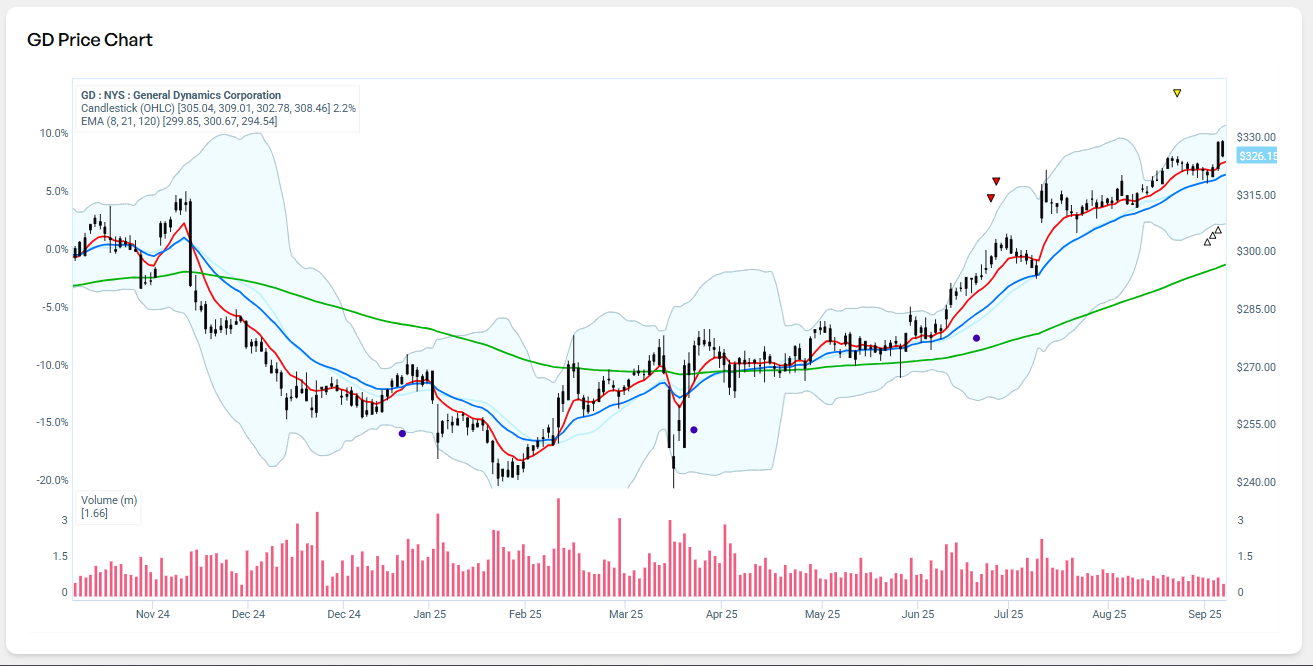General Dynamics is a global aerospace and defence company that specializes in ship construction and repair, land combat vehicles, weapons systems, munitions, and the manufacturing of products and services in business aviation. Approximately 85% of the company's total sales comes from North America.
General Dynamics (GD)

General Dynamics is one of the six defence contractors that make up the “Primes”, companies that have exclusive contracts with the U.S. Department of Defence (DOD).
General Dynamics has four operating segments: Technologies, Marine Systems, Aerospace, and Combat Systems.
The Technologies segment (about 35%) provides a full spectrum of services, technologies and products (IT solutions, mobile communication, computers, command, intelligence, surveillance and reconnaissance). It is organized into two business units - Information Technology (GDIT) and Mission Systems. GDIT modernizes large-scale IT enterprises and deploys the latest technologies to optimize and protect customer networks, data and information. Mission Systems develops and manufactures combat-proven global positioning systems (GPS) for the US Army.
General Dynamic's Marine Systems (about 30% of revenue) is a major shipbuilder for the US Navy, and it provides maintenance, modernization and lifecycle support services. The segment consists of three business units: Electric Boat, Bath Iron Works and NASSCO. Through Electric Boat, Marine Systems manufactures the Virginia-class nuclear-powered submarine and Columbia-class ballistic-missile submarine, while Bath Iron Works builds the Arleigh Burke-class guided-missile destroyer (DDG-51). NASSCO builds auxiliary and support ships for the US Navy, as well as oil tankers and container ships for commercial customers.
There are only two U.S. companies that can build nuclear submarines-General Dynamics and Huntington Ingalls.
On the civilian side of the business, the company's Aerospace segment (about 20% of revenue) produces jets and aircraft repair, support and completion services. The segment consists of the company's Gulfstream and Jet Aviation business units.
The Combat Systems division (roughly 20% of revenue) is composed of Land Systems, European Land Systems (ELS), and Ordnance and Tactical Systems (OTS). It offers combat vehicles, weapons systems and munitions for the US government and its non-US partners. Land Systems is the sole-source producer of two foundational products central to the US Army's warfighting capabilities: the M1A2 Abrams main battle tank and Stryker wheeled combat vehicle. ELS produces and upgrades Piranha vehicles, a premier 8x8 armoured combat vehicle, while OTS manufactures M2/M2-A1 heavy machine guns and MK19/MK47 grenade launchers.
The case for owning Defence and Aerospace companies like General Dynamics has never been more compelling. Russia’s aggression in Ukraine has prompted most European nations to significantly increase defence spending. After decades of under-investment, Europe’s key economies and members of NATO must spend more on defence as Russia's invasion of Ukraine reinforces the proximity of real threats. Effective deterrents would require spending to more than double to at least US$500 billion. Land forces need the largest overhaul given woefully inadequate ground forces. Also, lacking or deficient are bombers, attack, helicopters, airlift capabilities, submarines and surface navies.
The current U.S. 2022 defence budget of $778 billion is one of the largest ever. The Senate Armed Services Committee recently passed a national defence authorization for 2023 that would provide the Pentagon $817 billion. American military spending as a percent of GDP remains one of the highest in the world at 3.7%. Geopolitical tensions are not improving so it’s likely this will increase over time no matter which party is in the White House.
Canada has also just announced they will spend some $30 billion over two decades, with nearly $4 billion happening in the next six years, in order to secure their Arctic regions. Canadian officials say the threat to the north has escalated following Russia’s invasion of Ukraine.
Add to that the very real possibility of China invading Taiwan, the powder keg that is the Middle East, not to mention Iran’s nuclear ambitions and you could come to the conclusion that the world is still a dangerous place. Western democracies agree.
Defence companies are a rather unique beast. For the most part, they have decades of operating and production experience. Given the sophistication of modern weaponry, they are as much technology companies as they are manufacturing companies.
These companies are also somewhat “inflation proof” as most of them have contacts with price escalation clauses to cover higher costs of raw materials. U.S. defence contractors are insulated from inflation since they're usually able to pass along cost increases to the federal government, while military spending -- their largest revenue source --typically at least keeps pace with rising prices. That bodes well for protecting profit margins and growth over the coming years. Also, these companies are simply not impacted by macroeconomic conditions.
Important Information
All information contained in this publication is provided on a factual or general advice basis only and is not intended or be construed as an offer, solicitation, or a recommendation for any financial product unless expressly stated. All investments carry risks and past performance is no indicator of future performance. Before making an investment decision, you should consider your personal circumstances, objectives and needs and seek a professional investment advice. Opinions, estimates and projections constitute the current judgement of the author as at the date of this publication. Any comments, suggestions or views presented in this communication are not necessarily those of HALO Technologies, Macrovue or any of their related entities (‘we’, ‘our’, ‘us’), nor do they warrant a complete or accurate statement.
The opinions and recommendations in this publication are based on a reasonable assessment by the author who wrote the report using information provided by industry resources and generally available in the market. Employees and/or associates of HALO Technologies or any of the other related entities may hold one or more of the investments reviewed in this report. Any personal holdings by HALO Technologies or any of the other related entities employees and/or associates should not be seen as an endorsement or recommendation in any way. HALO Technologies Pty Limited ACN 623 830 866 is a Corporate Authorised Representative CAR: 001261916 of Macrovue Pty Limited ACN:600 022 679 AFSL 484264. MacroVue Pty Limited is a wholly owned subsidiary of HALO Technologies Pty Ltd. These companies are related entities with Amalgamated Australian Investment Group Limited ABN 81 140 208 288 (AAIG).


